Lightweight Neural Network for Holographic Reconstruction of Pseudorandom Binary Data
Abstract
1. Introduction
2. Materials and Methods
2.1. Neural Network Architectures
2.2. Training Datasets for Computer-Generated Holograms (HoloLightNet-Mini)
2.3. Training Datasets for Digital Holograms (HoloLightNet)
2.4. Training Procedure
3. Results
- Reconstruction of different versions of QR codes from holograms generated without additional noise. This scenario allows us to estimate the maximum achievable reconstruction quality under ideal conditions.
- Reconstruction of different versions of QR codes from holograms generated with additional noise. This scenario simulates the holograms’ registration in a real optical setup.
- Reconstruction of the fixed-version QR code from holograms generated with additional noise. This scenario evaluates the performance of neural network reconstruction when it is not affected by variation in QR code complexity.
3.1. Computer Holograms Generated Without Additional Noise
- The BER values decreased exponentially with the increase in QR code resolution.
- The BER values increased linearly with the QR code version.
3.2. Noisy Computer-Generated Holograms with Variation in QR Code Complexity
3.3. Noisy Computer-Generated Holograms Without Variability in QR Code Complexity
3.4. Image Reconstruction from Digital Holograms
4. Discussion
5. Conclusions
Author Contributions
Funding
Institutional Review Board Statement
Informed Consent Statement
Data Availability Statement
Conflicts of Interest
Abbreviations
| BER | Bit error rate |
| QR | Quick response |
| SLM | Spatial light modulator |
| LCoS | liquid crystal on silicon |
Appendix A
QR Codes in Holographic Applications

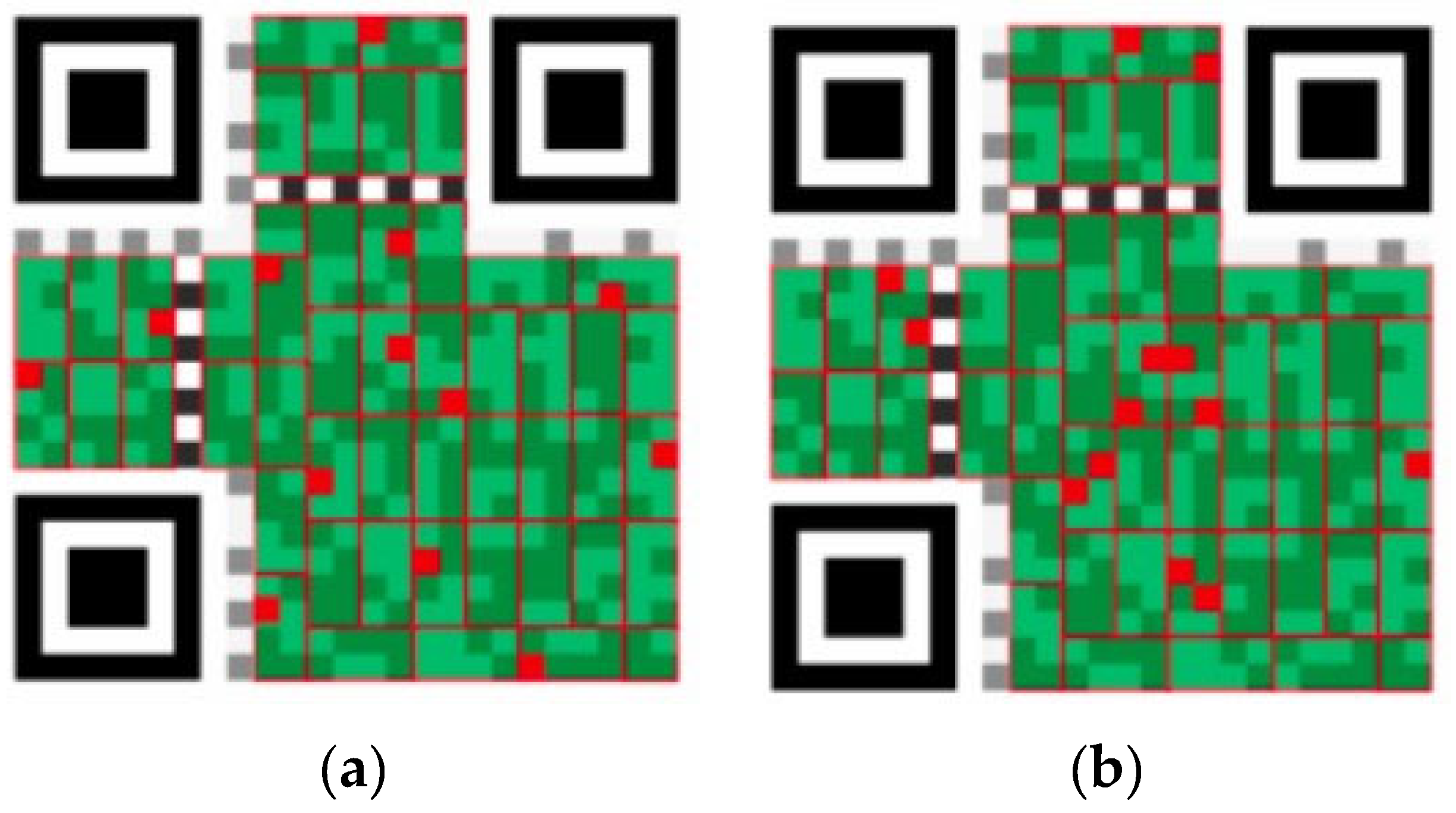
References
- Khodadad, D. Digital Holography and Its Application. Appl. Sci. 2024, 14, 11254. [Google Scholar] [CrossRef]
- Ferraro, P.; Alieva, T.; Memmolo, P.; Nehmetallah, G.; Zhang, Y. Recent breakthroughs in digital holography, 2D/3D imaging, and holographic optical elements: Introduction. J. Opt. Soc. Am. 2025, 64, DH1–DH2. [Google Scholar] [CrossRef] [PubMed]
- Tiwari, V.; Gopinath, S.; Kahro, T.; Arockiaraj, F.G.; Ignatius Xavier, A.P.; Joshi, N.; Kukli, K.; Tamm, A.; Juodkazis, S.; Rosen, J.; et al. Recent Advances in Spatially Incoherent Coded Aperture Imaging Technologies. Technologies 2025, 13, 210. [Google Scholar] [CrossRef]
- Tahara, T.; Shimobaba, T.; Kozawa, Y. Review on imaging and sensing with holography. J. Opt. 2025, 27, 043005. [Google Scholar] [CrossRef]
- Shi, Q. The Breakthrough of Holographic Projection Technology in Stage Art Front. Front. Art Res. 2025, 7, 100–104. [Google Scholar] [CrossRef]
- Rameez, A.; Hidayat, K.; Shakil, A. Revolutionary Hologram Systems: Pioneering a New Frontier in Visual Technology. Int. J. Innov. Sci. Technol. 2024, 6, 1943–1955. [Google Scholar]
- Haleem, A.; Javaid, M.; Khan, I.H. Holography applications toward medical field: An overview. Indian J. Radiol. Imaging 2020, 30, 354–361. [Google Scholar] [CrossRef]
- Kumar, M.; Murata, T.; Matoba, O. Live Cell Imaging by Single-Shot Common-Path Wide Field-of-View Reflective Digital Holographic Microscope. Sensors 2024, 24, 720. [Google Scholar] [CrossRef]
- Dyomin, V.; Polovtsev, I.; Davydova, A.; Kirillov, N. Spectroscopic aspects of underwater digital holography of plankton. Sci. Rep. 2025, 15, 1884. [Google Scholar] [CrossRef]
- Reztsov, T.V.; Chernykh, A.V.; Orlova, T.; Petrov, N.V. A Dynamic Analysis of Toron Formation in Chiral Nematic Liquid Crystals Using a Polarization Holographic Microscope. Polymers 2025, 17, 1849. [Google Scholar] [CrossRef] [PubMed]
- Hesselink, L.; Orlov, S.S.; Bashaw, M.C. Holographic data storage systems. Proc. IEEE 2004, 92, 1231–1280. [Google Scholar] [CrossRef]
- Minikhanov, T.Z.; Zlokazov, E.Y.; Cheremkhin, P.A.; Starikov, R.S.; Evtikhiev, N.N. Computer-Generated Holography Methods for Data Page Reconstruction Using Phase-Only Medium. Appl. Sci. 2023, 13, 4479. [Google Scholar] [CrossRef]
- Blanche, P.-A. Holography, and the future of 3D display. Light Adv. Manuf. 2021, 2, 446–459. [Google Scholar] [CrossRef]
- Pi, D.; Liu, J.; Wang, Y. Review of computer-generated hologram algorithms for color dynamic holographic three-dimensional display. Light Sci. Appl. 2022, 11, 231. [Google Scholar] [CrossRef]
- Kishk, S.; Javidi, B. Watermarking of by digital three-dimensional objects holography. Opt. Lett. 2003, 28, 167. [Google Scholar] [CrossRef] [PubMed]
- Chen, C.; Wei, Y.; Zhang, H.; Zhuang, Z.; Li, Z.; Shen, C.; Zhang, J.; Cai, H.; Chi, N.; Shi, J. Spatial Multiplexing Holography for Multi-User Visible Light Communication. Photonics 2025, 12, 160. [Google Scholar] [CrossRef]
- Sachin; Kumar, R.; Sakshi; Yadav, R.; Reddy, S.G.; Yadav, A.K.; Singh, P. Advances in Optical Visual Information Security: A Comprehensive Review. Photonics 2024, 11, 99. [Google Scholar] [CrossRef]
- Collier, R.J.; Burckhardt, C.B.; Lin, L.H. Optical Holography; Elsevier: Amsterdam, The Netherlands, 1971. [Google Scholar] [CrossRef]
- Schnars, U.; Jüptner, W. Digital Holography; Springer: Berlin/Heidelberg, Germany, 2005. [Google Scholar] [CrossRef]
- Sahin, E.; Stoykova, E.; Mäkinen, J.; Gotchev, A. 2021 Computer-Generated Holograms for 3D Imaging. ACM Comput. Surv. 2020, 53, 1–35. [Google Scholar] [CrossRef]
- Matsushima, K.; Arima, Y.; Nakahara, S. Digitized holography: Modern holography for 3D imaging of virtual and real objects. Appl. Opt. 2011, 50, H278. [Google Scholar] [CrossRef]
- Cuche, E.; Marquet, P.; Depeursinge, C. Spatial filtering for zero-order and twin-image elimination in digital off-axis holography. Appl. Opt. 2000, 39, 4070–4075. [Google Scholar] [CrossRef]
- Stoykova, E.S.E.; Kang, H.K.H.; Park, J.P.J. Twin-image problem in digital holography—A survey. Chin. Opt. Lett. 2014, 12, 060013-1–060013-12. [Google Scholar] [CrossRef]
- Arcab, P.; Rogalski, M.; Trusiak, M. Single-shot experimental-numerical twin-image removal in lensless digital holographic microscopy. Opt. Lasers Eng. 2024, 172, 107878. [Google Scholar] [CrossRef]
- Kozlov, A.V.; Cheremkhin, P.A.; Svistunov, A.S.; Rodin, V.G.; Starikov, R.S.; Evtikhiev, N.N. Interpolation-Filtering Method for Image Improvement in Digital Holography. Appl. Sci. 2024, 14, 8790. [Google Scholar] [CrossRef]
- Kim, J.; Lee, S.J. Digital in-line holographic microscopy for label-free identification and tracking of biological cells. Mil. Med. Res. 2024, 11, 38. [Google Scholar] [CrossRef] [PubMed]
- Picazo-Bueno, J.A.; Ketelhut, S.; Schnekenburger, J.; Micó, V.; Kemper, B. Off-axis digital lensless holographic microscopy based on spatially multiplexed interferometry. J. Biomed. Opt. 2024, 29, s22715. [Google Scholar] [CrossRef]
- Dufresne, E.R.; Spalding, G.C.; Dearing, M.T.; Sheets, S.A.; Grier, D.G. Computer-generated holographic optical tweezer arrays. Rev. Sci. Instrum. 2001, 72, 1810. [Google Scholar] [CrossRef]
- Liu, X.; Hu, Y.; Tu, S.; Kuang, C.; Liu, X.; Hao, X. Fast generation of arbitrary optical focus array. Opt. Lasers Eng. 2023, 162, 107405. [Google Scholar] [CrossRef]
- Wen, H.; Yang, L.; Bai, C.; Lin, Y.; Liu, T.; Chen, L.; Hu, Y.; He, D. Exploiting high-quality reconstruction image encryption strategy by optimized orthogonal compressive sensing. Sci. Rep. 2024, 14, 8805. [Google Scholar] [CrossRef]
- Chaudhary, H.; Garg, P.; Vishwakarma, V.P. Enhanced medical image watermarking using hybrid DWT-HMD-SVD and Arnold scrambling. Sci. Rep. 2025, 15, 9710. [Google Scholar] [CrossRef]
- Hassanzadeh, K.; Ahmadi-Kandjani, S.; Kheradmand, R.; Mortazavi, S.A. Approach to optical encryption: Merging ghost imaging with chaos theory. Opt. Express 2025, 33, 28301–28319. [Google Scholar] [CrossRef]
- Meteyer, E.; Pezerat, C.; Picart, P. Decorrelation and anti-correlation from defocus in digital holographic interferometry. J. Opt. Soc. Am. A 2023, 40, b33–b46. [Google Scholar] [CrossRef] [PubMed]
- Qi, Z.; Liang, W. Numerical Simulations of Single-Step Holographic Interferometry for Split-Ring Metamaterial Fabrication. Nanomaterials 2025, 15, 86. [Google Scholar] [CrossRef]
- Evtikhiev, N.N.; Zlokazov, E.Y.; Krasnov, V.V.; Rodin, V.G.; Starikov, R.S.; Cheremkhin, P.A. High-speed implementation of holographic and diffraction elements using digital micromirror devices. Quantum Electron. 2020, 50, 667–674. [Google Scholar] [CrossRef]
- Rhisheekesan, A.; Thomas, D.; Ulahannan, J.P.; Damodarakurup, S. Review on digital holography techniques using digital micromirror device. Opt. Lasers Eng. 2024, 177, 108120. [Google Scholar] [CrossRef]
- Huang, Z.; Cao, L. Quantitative phase imaging based on holography: Trends and new perspectives. Light: Sci. Appl. 2024, 13, 145. [Google Scholar] [CrossRef]
- Goodman, J.W. Introduction to Fourier Optics, 3rd ed.; Roberts & Co.: Greenwood Village, CO, USA, 2005. [Google Scholar]
- Latychevskaia, T. Iterative phase retrieval for digital holography: Tutorial. J. Opt. Soc. Am. 2019, 36, D31–D40. [Google Scholar] [CrossRef] [PubMed]
- Rivenson, Y.; Zhang, Y.; Günaydın, H.; Teng, D.; Ozcan, A. Phase recovery and holographic image reconstruction using deep learning in neural networks. Light Sci. Appl. 2018, 7, 17141. [Google Scholar] [CrossRef] [PubMed]
- González-Santoyo, C.; Renza, D.; Moya-Albor, E. Identifying and Mitigating Label Noise in Deep Learning for Image Classification. Technologies 2025, 13, 132. [Google Scholar] [CrossRef]
- Lindsay, M.; Kovaleski, S.D.; Veal, C.; Anderson, D.T.; Price, S.R. Machine learning assisted holography. Proc. Comput. Imaging VI 2021, 11731, 2. [Google Scholar] [CrossRef]
- Zhu, Y.; Huang, M.; Zhu, Y.; Jiang, J.; Zhang, Y. HDF-Net: Hierarchical Dual-Branch Feature Extraction Fusion Network for Infrared and Visible Image Fusion. Sensors 2025, 25, 3411. [Google Scholar] [CrossRef]
- Jiayi, Q.; Yansong, J.; Yiping, C.; Haitao, W. Single-shot phase-shifting composition fringe projection profilometry by multi-attention fringe restoration network. Neurocomputing 2025, 634, 129908. [Google Scholar] [CrossRef]
- Kazanskiy, N.L.; Khonina, S.N.; Oseledets, I.V.; Nikonorov, A.V.; Butt, M.A. Revolutionary Integration of Artificial Intelligence with Meta-Optics-Focus on Metalenses for Imaging. Technologies 2024, 12, 143. [Google Scholar] [CrossRef]
- Thakur, G.K.; Thakur, A.; Kulkarni, S.; Khan, N.; Khan, S. Deep Learning Approaches for Medical Image Analysis and Diagnosis. Cureus 2024, 16, e59507. [Google Scholar] [CrossRef] [PubMed]
- Zuo, C.; Qian, J.; Feng, S.; Yin, W.; Li, Y.; Fan, P.; Han, J.; Qian, K.; Chen, Q. Deep learning in optical metrology: A review. Light Sci. Appl. 2022, 11, 39. [Google Scholar] [CrossRef]
- Reyes-Vera, E.; Valencia-Arias, A.; García-Pineda, V.; Aurora-Vigo, E.F.; Alvarez Vásquez, H.; Sánchez, G. Machine Learning Applications in Optical Fiber Sensing: A Research Agenda. Sensors 2024, 24, 2200. [Google Scholar] [CrossRef]
- Lininger, A.; Aththanayake, A.; Boyd, J.; Ali, O.; Goel, M.; Jizhe, Y.; Hinczewski, M.; Strangi, G. Machine learning to optimize additive manufacturing for visible photonics. Nanophotonics 2023, 12, 2767–2778. [Google Scholar] [CrossRef]
- Fu, T.; Zhang, J.; Sun, R.; Huang, Y.; Xu, W.; Yang, S.; Zhu, Z.; Chen, H. Optical neural networks: Progress and challenges. Light: Sci. Appl. 2024, 13, 263. [Google Scholar] [CrossRef]
- Hadad, B.; Froim, S.; Yosef, E.; Giryes, R.; Bahabad, A. Deep learning in optics-a tutorial. J. Opt. 2023, 25, 123501. [Google Scholar] [CrossRef]
- Zeng, T.; Zhu, Y.; Lam, E.Y. Deep learning for digital holography: A review. Opt. Express 2021, 29, 40572. [Google Scholar] [CrossRef]
- Situ, G. Deep holography. Light. Adv. Manuf. 2022, 3, 278–300. [Google Scholar] [CrossRef]
- Cheremkhin, P.A.; Rymov, D.A.; Svistunov, A.S.; Zlokazov, E.Y.; Starikov, R.S. Neural-network—based methods in digital and computer-generated holography: A review. J. Opt. Technol. 2024, 91, 170. [Google Scholar] [CrossRef]
- Montresor, S.; Tahon, M.; Picart, P. Deep learning speckle de-noising algorithms for coherent metrology: A review and a phase-shifted iterative scheme [Invited]. J. Opt. Soc. Am. A 2022, 39, A62. [Google Scholar] [CrossRef] [PubMed]
- Wang, K.; Dou, J.; Kemao, Q.; Di, J.; Zhao, J. Y-Net: A one-to-two deep learning framework for digital holographic reconstruction. Opt. Lett. 2019, 44, 4765. [Google Scholar] [CrossRef]
- Svistunov, A.S.; Rymov, D.A.; Starikov, R.S.; Cheremkhin, P.A. HoloForkNet: Digital Hologram Reconstruction via Multibranch Neural Network. Appl. Sci. 2023, 13, 6125. [Google Scholar] [CrossRef]
- Chen, B.; Li, Z.; Zhou, Y.; Zhang, Y.; Jia, J.; Wang, Y. Deep-Learning Multiscale Digital Holographic Intensity and Phase Reconstruction. Appl. Sci. 2023, 13, 9806. [Google Scholar] [CrossRef]
- Kiriy, S.A.; Rymov, D.A.; Svistunov, A.S.; Shifrina, A.V.; Starikov, R.S.; Cheremkhin, P.A. Generative adversarial neural network for 3D-hologram reconstruction. Laser Phys. Lett. 2024, 21, 045201. [Google Scholar] [CrossRef]
- Chen, D.; Guo, Z.; Guan, H.; Chen, X. Lensless Digital Holographic Reconstruction Based on the Deep Unfolding Iterative Shrinkage Thresholding Network. Electronics 2025, 14, 1697. [Google Scholar] [CrossRef]
- Zeng, T.; So, H.K.-H.; Lam, E.Y. RedCap: Residual encoder-decoder capsule network for holographic image reconstruction. Opt. Express 2020, 28, 4876. [Google Scholar] [CrossRef]
- Ren, Z.; Xu, Z.; Lam, E.Y. End-to-end deep learning framework for digital holographic reconstruction. Adv. Photonics 2019, 1, 016004. [Google Scholar] [CrossRef]
- Wang, H.; Lyu, M.; Situ, G. eHoloNet: A learning-based end-to-end approach for in-line digital holographic reconstruction. Opt. Express 2018, 26, 22603. [Google Scholar] [CrossRef]
- Kim, J.; Kim, Y.; Lee, H.S.; Seo, E.; Lee, S.J. Single-shot reconstruction of three-dimensional morphology of biological cells in digital holographic microscopy using a physics-driven neural network. Nat. Commun. 2025, 16, 4840. [Google Scholar] [CrossRef]
- Bravo-Frank, N.; Zende, R.; Feng, L.; Mesyngier, N.; Pachpute, A.; Hong, J. Realtime bacteria detection and analysis in sterile liquid products using deep learning holographic imaging. Npj Biosensing 2024, 1, 8. [Google Scholar] [CrossRef]
- Luo, H.; Xu, J.; Jiao, J.; Zhong, L.; Lu, X.; Tian, J. Moment-Based Shape-Learning Holography for Fast Classification of Microparticles. Adv. Photonics Res. 2023, 4, 2300120. [Google Scholar] [CrossRef]
- Khorin, P.A.; Dzyuba, A.P.; Chernykh, A.V.; Georgieva, A.O.; Petrov, N.V.; Khonina, S.N. Neural Network-Assisted Interferogram Analysis Using Cylindrical and Flat Reference Beams. Appl. Sci. 2023, 13, 4831. [Google Scholar] [CrossRef]
- Evtikhiev, N.N.; Starikov, S.N.; Cheremkhin, P.A.; Kurbatova, E.A. Evaluation of diffraction efficiency and image quality in optical reconstruction of digital Fresnel holograms. Radiophys. Quantum Electron. 2015, 57, 635–649. [Google Scholar] [CrossRef]
- Maurer, C.; Schwaighofer, A.; Jesacher, A.; Bernet, S.; Ritsch-Marte, M. Suppression of undesired diffraction orders of binary phase holograms. Appl. Opt. 2008, 47, 3994. [Google Scholar] [CrossRef]
- ISO/IEC 18004:2015; 2015 Information Technology: Automatic Identification and Data Capture Techniques, QR Code 2005 Bar Code Symbology Specification. ISO Copyright Office: Geneva, Switzerland, 2015; ISO Stand. 2015 114.
- Hong, J.H. Volume holographic memory systems: Techniques and architectures. Opt. Eng. 1995, 34, 2193. [Google Scholar] [CrossRef]
- Ronneberger, O.; Fischer, P.; Brox, T. U-Net: Convolutional Networks for Biomedical Image Segmentation. In Proceedings of the Medical Image Computing and Computer-Assisted Intervention—MICCAI 2015, Munich, Germany, 5–9 October 2015; Volume 9351, pp. 234–241. [Google Scholar]
- Abbasi, M.; Váz, P.; Silva, J.; Martins, P. Enhancing Visual Perception in Immersive VR and AR Environments: AI-Driven Color and Clarity Adjustments Under Dynamic Lighting Conditions. Technologies 2024, 12, 216. [Google Scholar] [CrossRef]
- Temenos, A.; Temenos, N.; Doulamis, A.; Doulamis, N. On the Exploration of Automatic Building Extraction from RGB Satellite Images Using Deep Learning Architectures Based on U-Net. Technologies 2022, 10, 19. [Google Scholar] [CrossRef]
- QR Code Reconstruction. Available online: https://github.com/k1121/qrcode-reconstruction (accessed on 15 October 2025).
- Khorin, P.A.; Dzyuba, A.P.; Chernykh, A.V.; Butt, M.A.; Khonina, S.N. Application of Machine Learning Methods for Identifying Wave Aberrations from Combined Intensity Patterns Generated Using a Multi-Order Diffractive Spatial Filter. Technologies 2025, 13, 212. [Google Scholar] [CrossRef]
- Richard, M.D.; Lippmann, R.P. Neural Network Classifiers Estimate Bayesian a posteriori Probabilities. Neural Comput. 1991, 3, 461–483. [Google Scholar] [CrossRef] [PubMed]
- Blahut, R.E. Information Theory and Coding. In Reference Data for Engineers; Elsevier: Amsterdam, The Netherlands, 2002; pp. 25-1–25-31. [Google Scholar]
- Howard, A.G.; Zhu, M.; Chen, B.; Kalenichenko, D.; Wang, W.; Weyand, T.; Andreetto, M.; Adam, H. MobileNets: Efficient Convolutional Neural Networks for Mobile Vision Applications. arXiv 2017. [Google Scholar] [CrossRef]
- Xie, E.; Wang, W.; Yu, Z.; Anandkumar, A.; Alvarez, J.M.; Luo, P. SegFormer: Simple and Efficient Design for Semantic Segmentation with Transformers. arXiv 2021, 34, 12077–12090. [Google Scholar] [CrossRef]
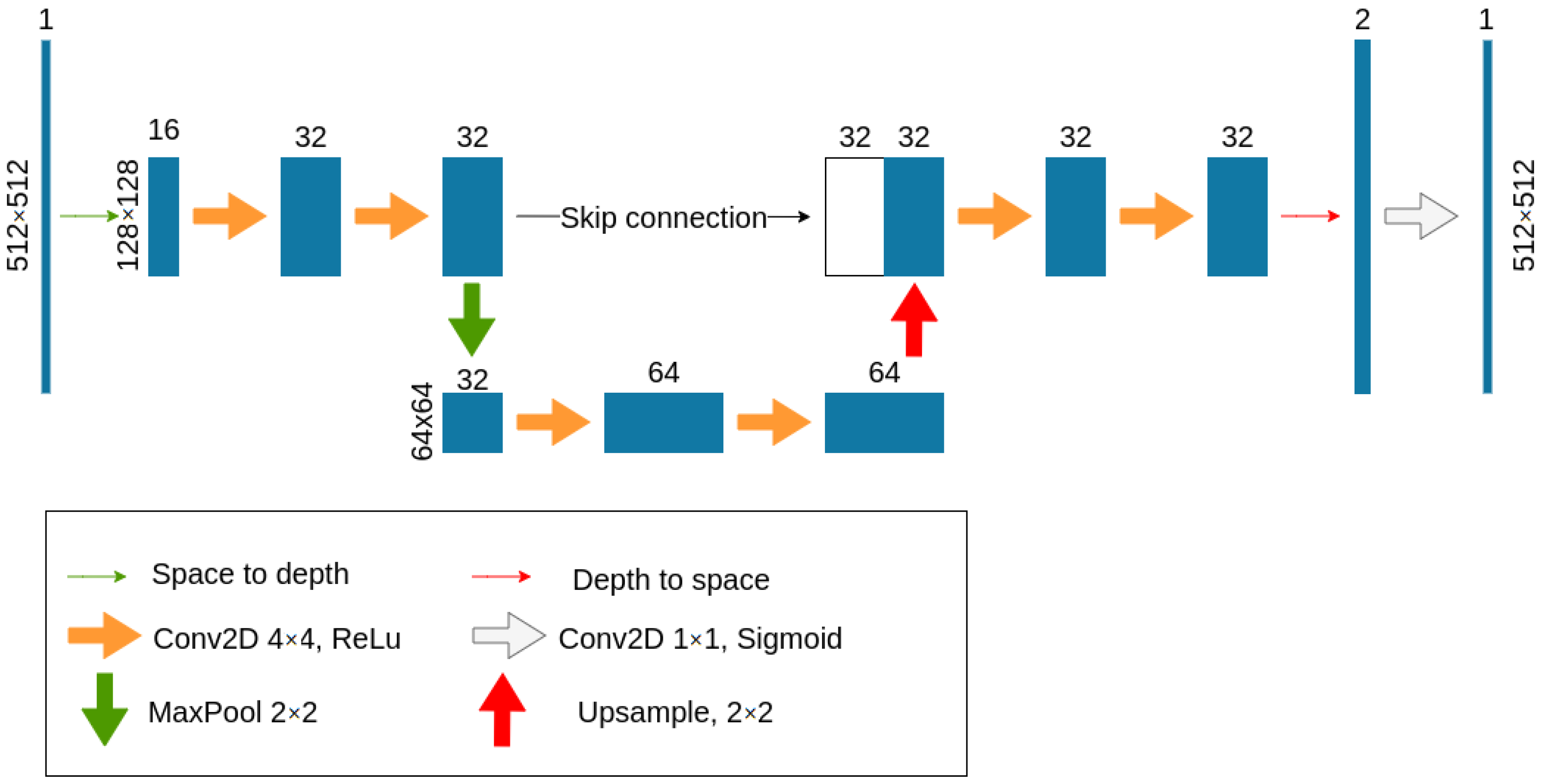
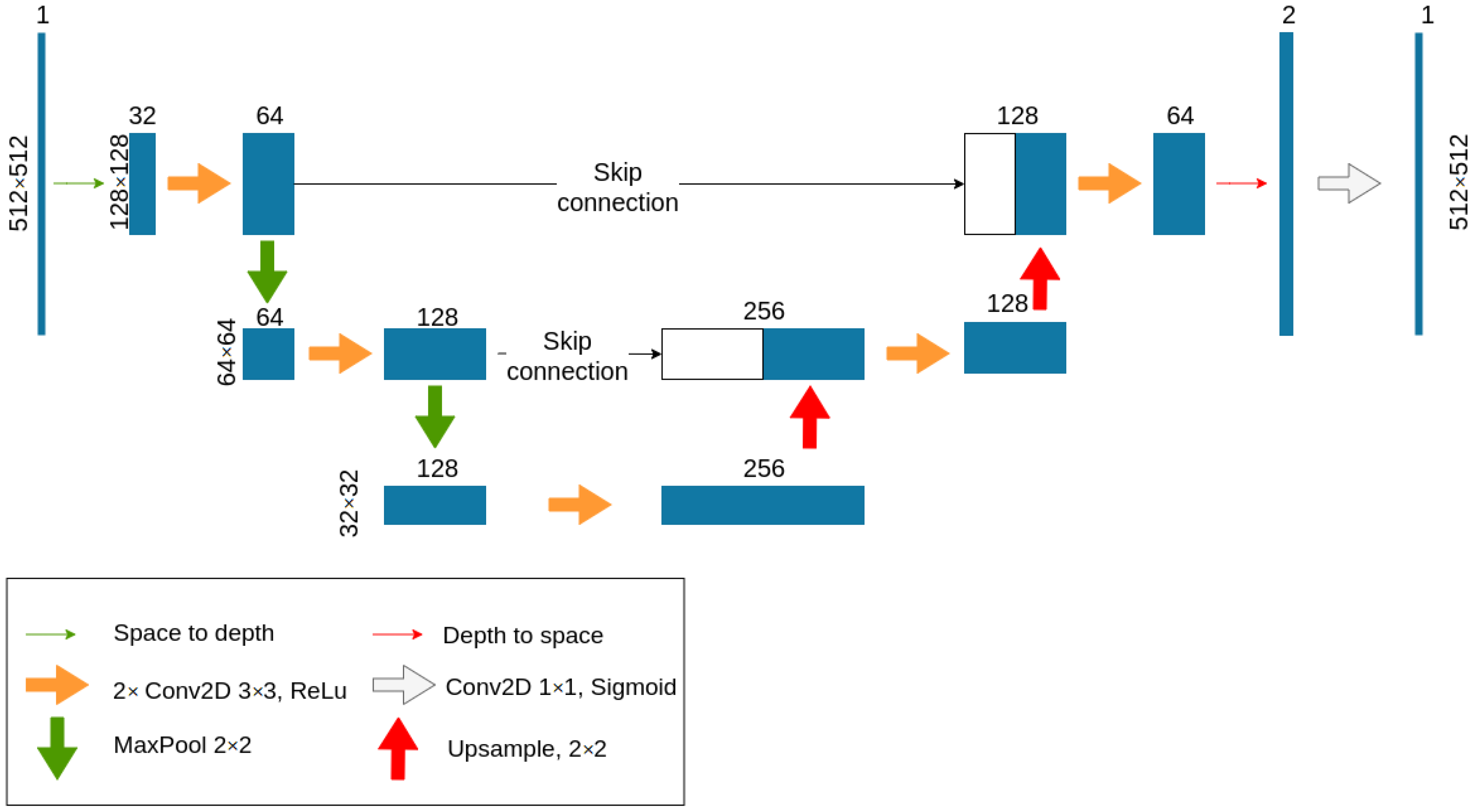
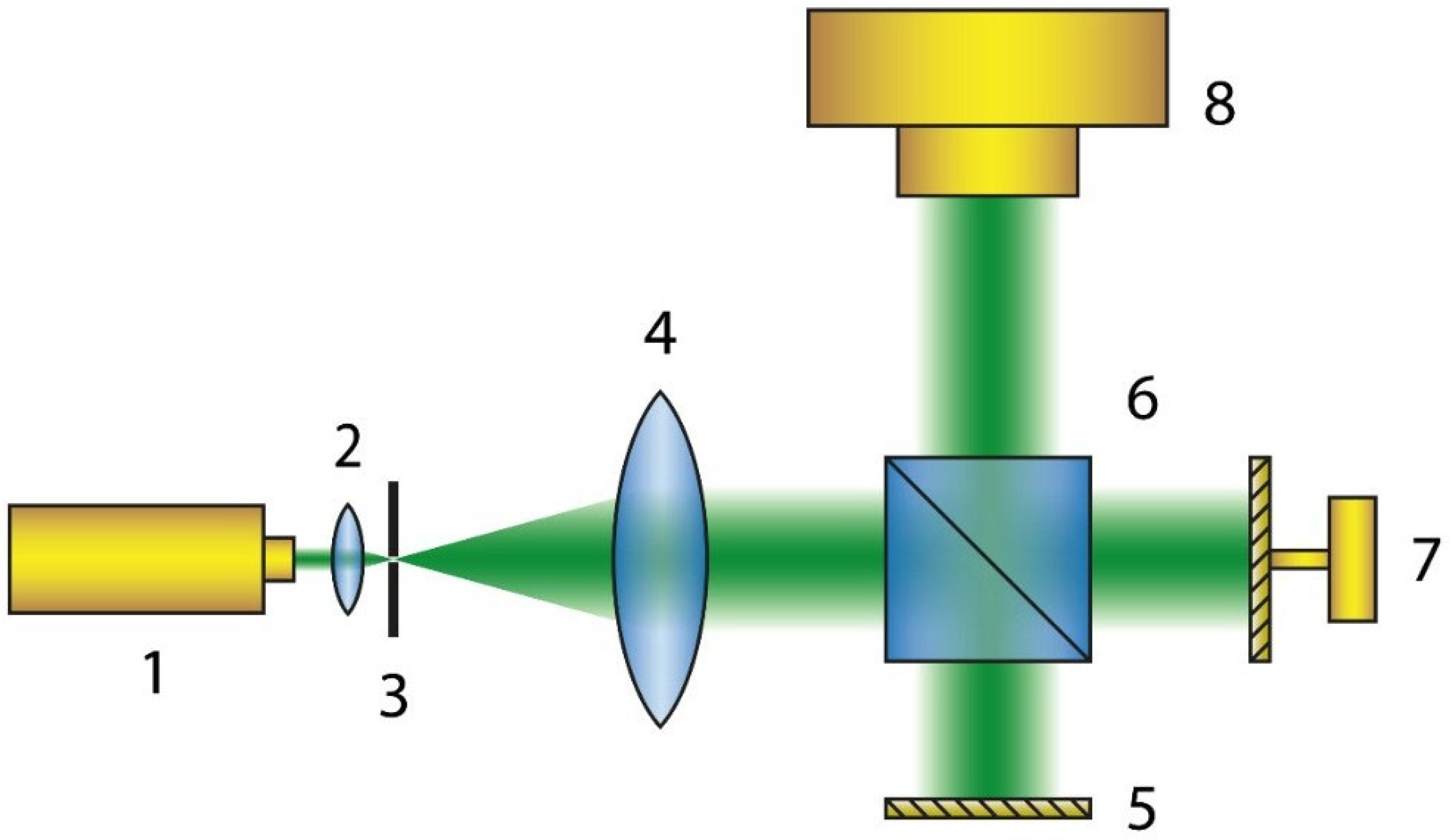
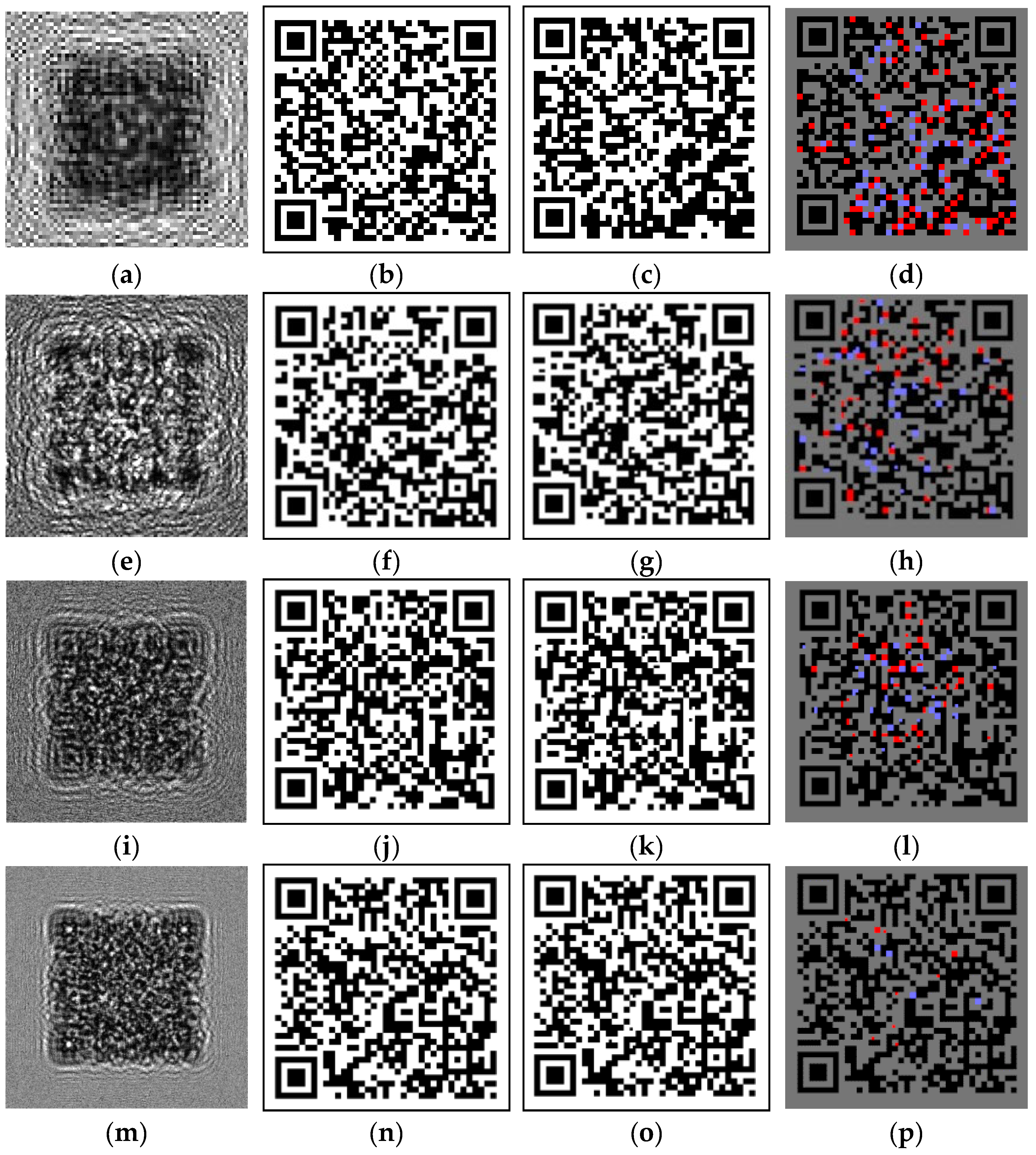
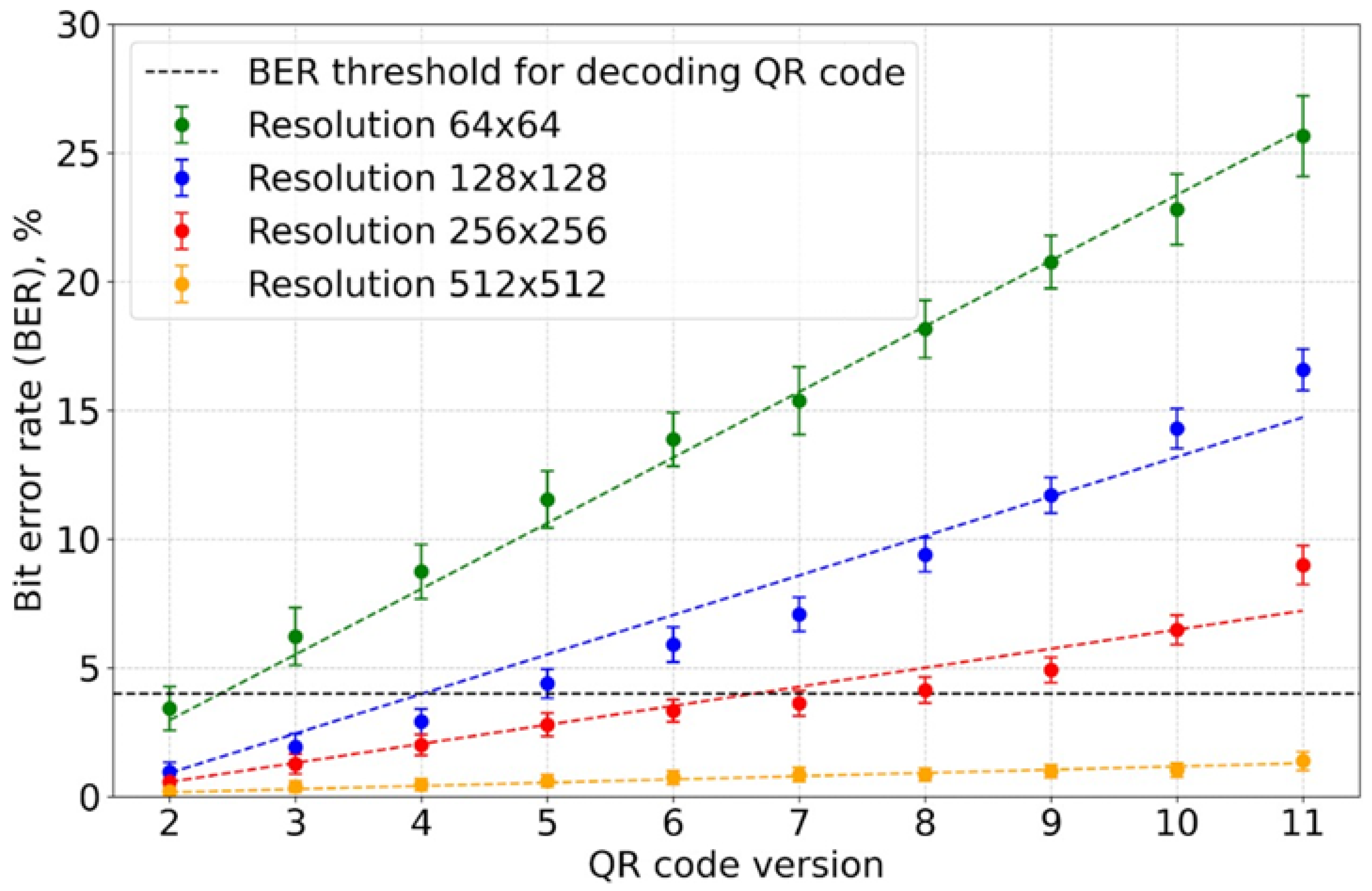

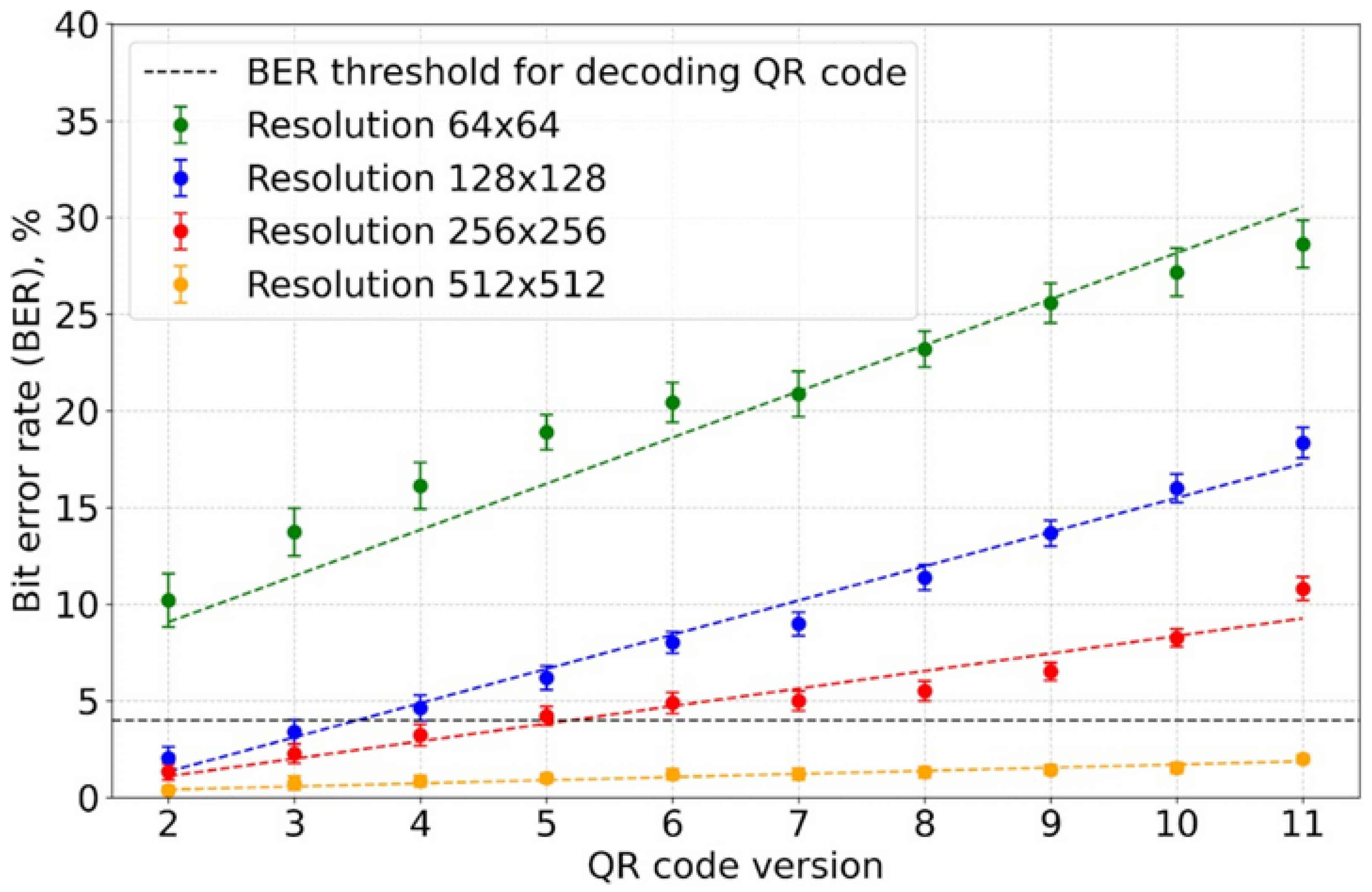
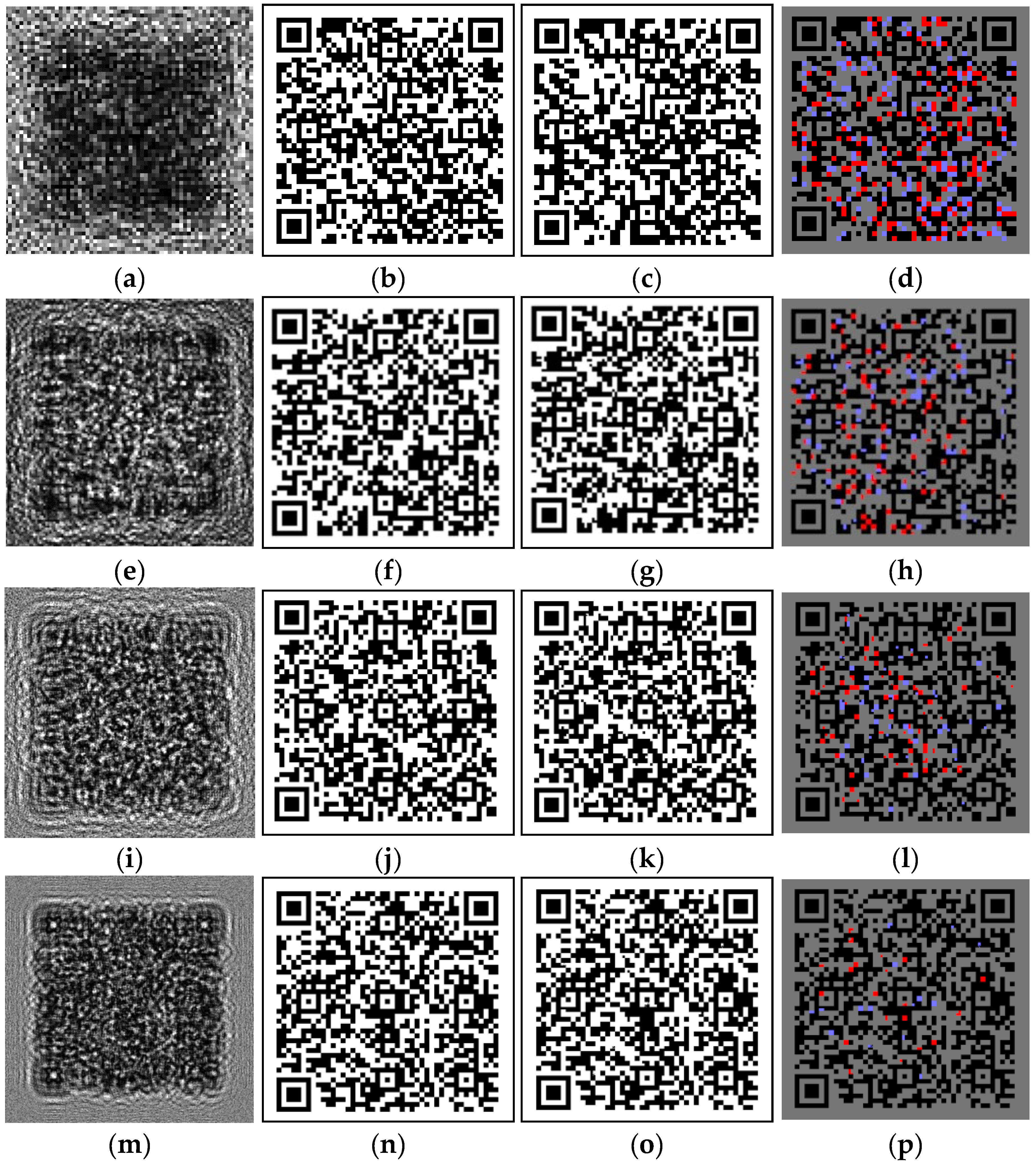
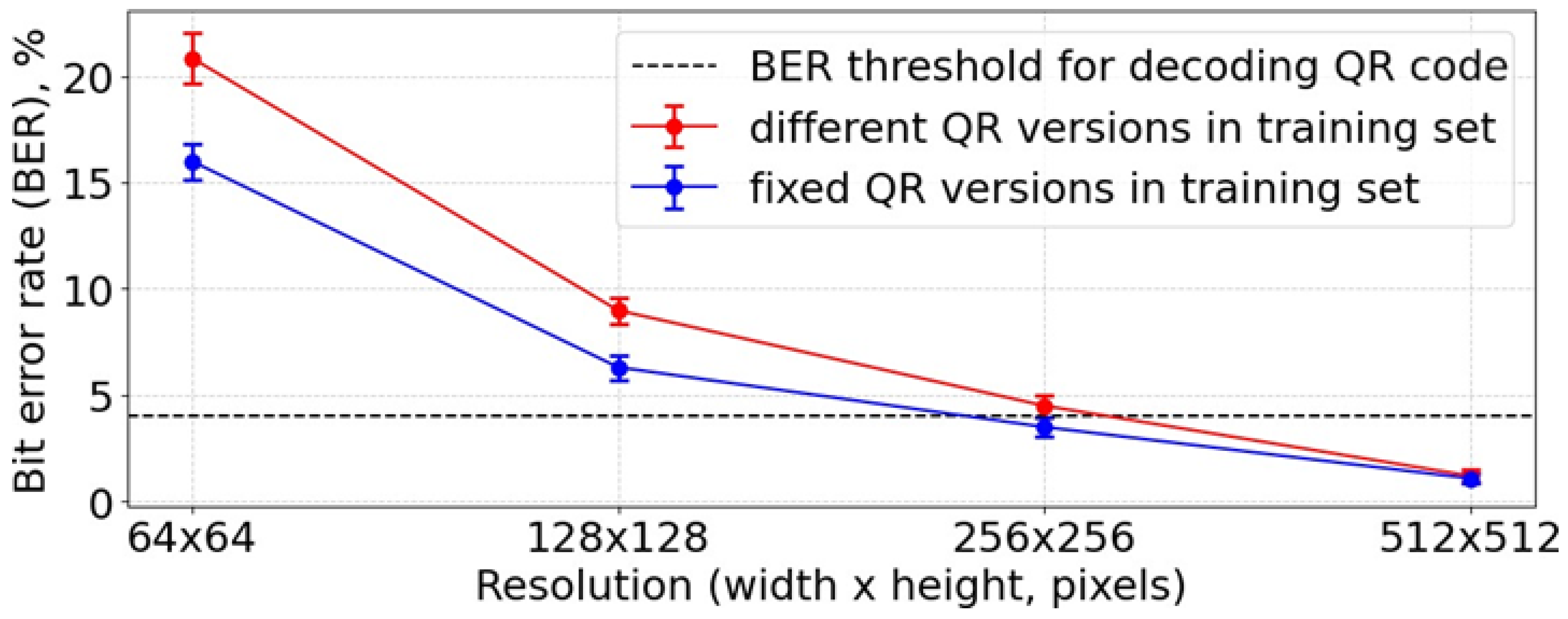
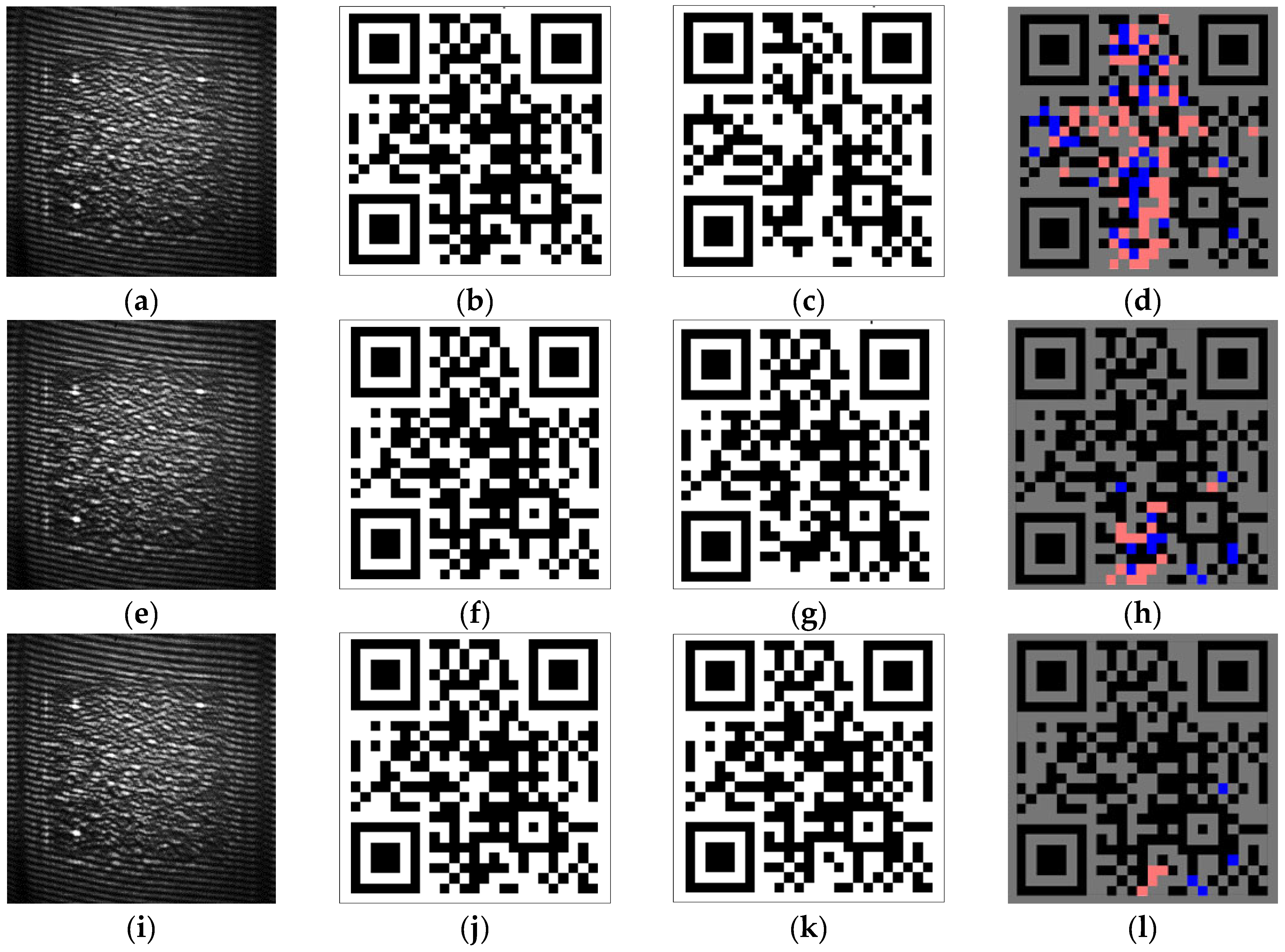

Disclaimer/Publisher’s Note: The statements, opinions and data contained in all publications are solely those of the individual author(s) and contributor(s) and not of MDPI and/or the editor(s). MDPI and/or the editor(s) disclaim responsibility for any injury to people or property resulting from any ideas, methods, instructions or products referred to in the content. |
© 2025 by the authors. Licensee MDPI, Basel, Switzerland. This article is an open access article distributed under the terms and conditions of the Creative Commons Attribution (CC BY) license (https://creativecommons.org/licenses/by/4.0/).
Share and Cite
Drozdov, M.K.; Rymov, D.A.; Svistunov, A.S.; Cheremkhin, P.A.; Shifrina, A.V.; Kiriy, S.A.; Zlokazov, E.Y.; Petrova, E.K.; Nebavskiy, V.A.; Evtikhiev, N.N.; et al. Lightweight Neural Network for Holographic Reconstruction of Pseudorandom Binary Data. Technologies 2025, 13, 474. https://doi.org/10.3390/technologies13100474
Drozdov MK, Rymov DA, Svistunov AS, Cheremkhin PA, Shifrina AV, Kiriy SA, Zlokazov EY, Petrova EK, Nebavskiy VA, Evtikhiev NN, et al. Lightweight Neural Network for Holographic Reconstruction of Pseudorandom Binary Data. Technologies. 2025; 13(10):474. https://doi.org/10.3390/technologies13100474
Chicago/Turabian StyleDrozdov, Mikhail K., Dmitry A. Rymov, Andrey S. Svistunov, Pavel A. Cheremkhin, Anna V. Shifrina, Semen A. Kiriy, Evgenii Yu. Zlokazov, Elizaveta K. Petrova, Vsevolod A. Nebavskiy, Nikolay N. Evtikhiev, and et al. 2025. "Lightweight Neural Network for Holographic Reconstruction of Pseudorandom Binary Data" Technologies 13, no. 10: 474. https://doi.org/10.3390/technologies13100474
APA StyleDrozdov, M. K., Rymov, D. A., Svistunov, A. S., Cheremkhin, P. A., Shifrina, A. V., Kiriy, S. A., Zlokazov, E. Y., Petrova, E. K., Nebavskiy, V. A., Evtikhiev, N. N., & Starikov, R. S. (2025). Lightweight Neural Network for Holographic Reconstruction of Pseudorandom Binary Data. Technologies, 13(10), 474. https://doi.org/10.3390/technologies13100474





